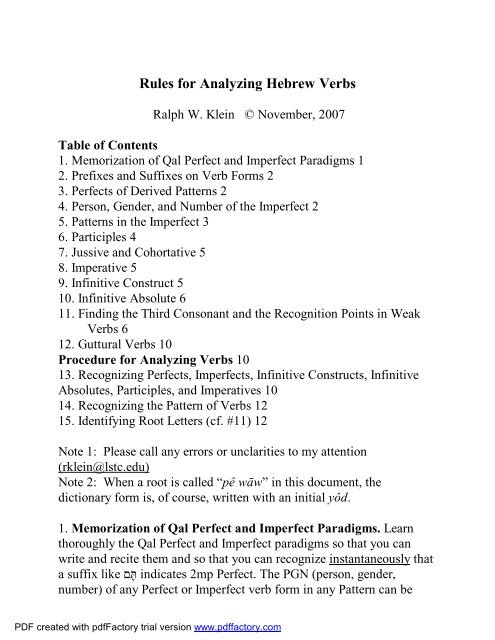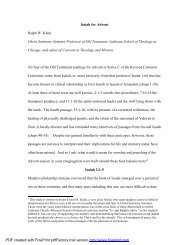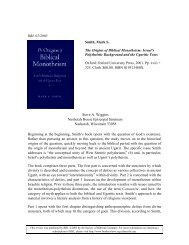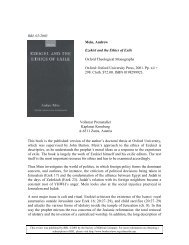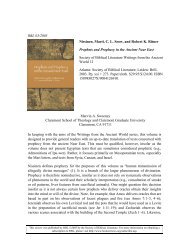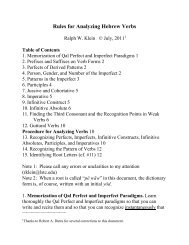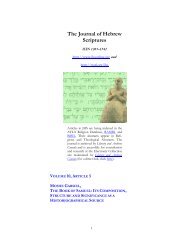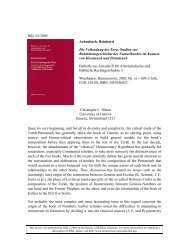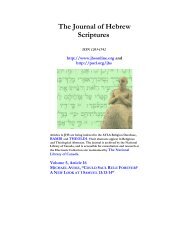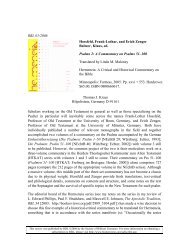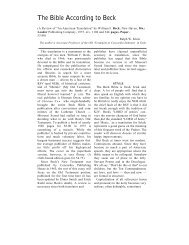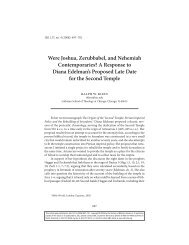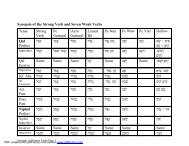Rules for Analyzing Hebrew Verbs
Rules for Analyzing Hebrew Verbs
Rules for Analyzing Hebrew Verbs
Create successful ePaper yourself
Turn your PDF publications into a flip-book with our unique Google optimized e-Paper software.
<strong>Rules</strong> <strong>for</strong> <strong>Analyzing</strong> <strong>Hebrew</strong> <strong>Verbs</strong><br />
Ralph W. Klein © November, 2007<br />
Table of Contents<br />
1. Memorization of Qal Perfect and Imperfect Paradigms 1<br />
2. Prefixes and Suffixes on Verb Forms 2<br />
3. Perfects of Derived Patterns 2<br />
4. Person, Gender, and Number of the Imperfect 2<br />
5. Patterns in the Imperfect 3<br />
6. Participles 4<br />
7. Jussive and Cohortative 5<br />
8. Imperative 5<br />
9. Infinitive Construct 5<br />
10. Infinitive Absolute 6<br />
11. Finding the Third Consonant and the Recognition Points in Weak<br />
<strong>Verbs</strong> 6<br />
12. Guttural <strong>Verbs</strong> 10<br />
Procedure <strong>for</strong> <strong>Analyzing</strong> <strong>Verbs</strong> 10<br />
13. Recognizing Perfects, Imperfects, Infinitive Constructs, Infinitive<br />
Absolutes, Participles, and Imperatives 10<br />
14. Recognizing the Pattern of <strong>Verbs</strong> 12<br />
15. Identifying Root Letters (cf. #11) 12<br />
Note 1: Please call any errors or unclarities to my attention<br />
(rklein@lstc.edu)<br />
Note 2: When a root is called “pê wāw” in this document, the<br />
dictionary <strong>for</strong>m is, of course, written with an initial yôd.<br />
1. Memorization of Qal Perfect and Imperfect Paradigms. Learn<br />
thoroughly the Qal Perfect and Imperfect paradigms so that you can<br />
write and recite them and so that you can recognize instantaneously that<br />
a suffix like םתֶּ indicates 2mp Perfect. The PGN (person, gender,<br />
number) of any Perfect or Imperfect verb <strong>for</strong>m in any Pattern can be<br />
PDF created with pdfFactory trial version www.pdffactory.com
<strong>Rules</strong> <strong>for</strong> Verb Analysis (2)<br />
identified by knowledge of the Qal Paradigm. In every Pattern there are<br />
two stems: The Perfect Stem and the Imperfect Stem (usually the<br />
Imperative, Infinitive Construct and Infinitive Absolute, and Participle<br />
are based on the Imperfect Stem). In the Qal the Infinitive Absolute and<br />
Participle are not based on this stem and must be memorized. On the<br />
Niphal participle, see below.<br />
***********************************************************<br />
2. Prefixes and Suffixes on Verb Forms. Begin analysis of any verb<br />
<strong>for</strong>m by marking off the prefixes and suffixes.<br />
[ תְּ ]לטק [ הנָ]לטק[ת] [ וּ]םחנ<br />
The first example is Perfect 2fs (תְּ ), the second 3fp or 2fp Imperfect ( תּ<br />
הנָ), and all we can say about the third (וּ) is that it is 3 common plural<br />
perfect or masculine plural imperative.<br />
***********************************************************<br />
3. Perfects of Derived Patterns. For the Perfects of the Derived<br />
Patterns (everything but Qal), let the name of the Pattern be your guide<br />
(that is, the 3ms will sound like the name of the Pattern). Niphal begins<br />
with nûn, Piel and Pual have a dāgēš <strong>for</strong>te in their middle character and<br />
can be distinguished by their vowel sequence (i-e <strong>for</strong> Piel, or u-a <strong>for</strong><br />
Pual); Hiphil, Hophal, and Hithpael begin with Hi-, Ho- (qāmes. h.ātûp)<br />
and Hith- respectively.<br />
If the <strong>for</strong>m is perfect, as identified by the suffix, and there are no<br />
prefixes and no dāgēšes, the <strong>for</strong>m is Qal. e.g. יתִּ מְ קַ from םוּק<br />
***********************************************************<br />
4. Person, Gender, and Number of the Imperfect. If an Imperfect<br />
has a yôd prefix, it is a 3m <strong>for</strong>m (singular or plural);<br />
PDF created with pdfFactory trial version www.pdffactory.com
if it has a tāw prefix, it is a 3f or 2m-2f <strong>for</strong>m (singular or plural);<br />
if it has an āleph or nûn prefix it is a 1st person <strong>for</strong>m (singular<br />
and plural respectively).<br />
***********************************************************<br />
5. Patterns in the Imperfect. Identify the Pattern of Imperfects and<br />
other <strong>for</strong>ms based on the Imperfect Stem (usually the Imperative,<br />
Infinitive Construct and Infinitive Absolute, and Participle are based on<br />
the Imperfect Stem) by the recognition points.<br />
Qal: h.îreq-šĕwă . קְיִ or קְנִ , etc.<br />
<strong>Rules</strong> <strong>for</strong> Verb Analysis (3)<br />
Niphal: Niphal triangle לטֵקָּ יִ (a triangle is <strong>for</strong>med by h.îreq--dāgēš<br />
<strong>for</strong>te--qāmes.)<br />
With a Guttural ןמֵאָיֵ (Compensative lengthening instead of<br />
dāgēš <strong>for</strong>te)<br />
Pê Wāw בשֵׁוָּיִ (Note the Niphal triangle)<br />
(With a Hollow Verb ןוֹכּיִ The dāgēš results from the assimilation<br />
of the Nûn of the Niphal)<br />
Piel and Pual: A dāgēš <strong>for</strong>te will be in the middle letter and a vocal<br />
šĕwă under the prefix consonant; one can distinguish Piel from Pual<br />
by the sound of the vowels (a Pual will have a qibbûs. under the first root<br />
consonant).<br />
לטֵּ קַ יְ לטַּ קֻיְ<br />
The dāgēš in the middle letter sometimes disappears when<br />
there is a šĕwă under the letter (Seow, p. 59).<br />
Note: By definition, a Hollow verb cannot double its middle<br />
letter. Instead we have patterns called Polel (םמֵוֹקיְ) and<br />
Polal (םמַוֹקיְ). That is, the final letter of the Hollow root is<br />
PDF created with pdfFactory trial version www.pdffactory.com
<strong>Rules</strong> <strong>for</strong> Verb Analysis (4)<br />
doubled. The <strong>for</strong>ms above are Imperfects; these patterns also<br />
have all the other tenses.<br />
Hiphil: Note the patah. under the prefix ליטִקְיַ<br />
[Sometimes a patahD will show up in the Qal prefix be<strong>for</strong>e verbs<br />
beginning with a guttural דמֹ עֲיַ].<br />
Hophal: Note the qāmes. h.at.ûp under the prefix followed by a silent<br />
šĕwă לטַקְיָ.<br />
A qāmes. h.āt.ûp is a short vowel and appears only in a closed,<br />
unaccented syllable. Be<strong>for</strong>e dāgēš <strong>for</strong>te, the qāmes. h.āt.ûp is<br />
replaced by a qibbûs.. שׁגַּהֻ = Hophal Perfect from שׁגנ.<br />
Hithpael: yith-, tith-, eth-, or nith- prefix תְנִ ,תְאֶ ,תְתִ ,תְיִ There will also<br />
be a dāgēš <strong>for</strong>te in the middle letter of the root.<br />
Note: By definition a Hollow verb cannot double its middle letter.<br />
Instead we have Hithpolel (םמֵוֹקתְיִ). That is, the final letter of the root is<br />
doubled.<br />
***********************************************************<br />
6. Participles. In Piel through Hithpael the Participles begin with a<br />
mêm and are based on the imperfect stem.<br />
לטֵּ קַ מְ , לטָּ קֻמְ , ליטִקְמַ, לטָקְמָ, or לטֵּ קַ תְ מִ<br />
In the Qal and Niphal the participles are not based on the imperfect<br />
stem and must be memorized:<br />
Qal Active Qal Passive Niphal<br />
לטֵקֹ לוּטקָ לטָקְנִ<br />
םקָ (Qal active participle from a Hollow verb םוּק)<br />
PDF created with pdfFactory trial version www.pdffactory.com
<strong>Rules</strong> <strong>for</strong> Verb Analysis (5)<br />
***********************************************************<br />
7. Jussive and Cohortative. Jussives and Cohortatives express the<br />
speaker’s will to have a situation occur (May she...; let us...). The<br />
Jussive (3rd and 2nd person <strong>for</strong>ms) is distinguished from the Imperfect<br />
in the Strong Verb only in the Hiphil where the vowel is shortened in<br />
the second syllable. In all other Patterns the <strong>for</strong>ms can be either<br />
Imperfect or Jussive.<br />
Hiphil Imperfect ליטִקְיַ Hiphil Jussive לטֵקְיַ<br />
(In the weak verbs, the Jussive is distinguished from the imperfect by a<br />
shortening of the stem vowel. See #11 below)<br />
The Cohortative (1st person <strong>for</strong>ms) adds a final qāmes. he to the<br />
imperfect. הלָטְקְאֶ and הלָטְקנִ<br />
***********************************************************<br />
8. Imperative. The imperative is <strong>for</strong>med in the Qal and Piel by<br />
removing the prefix from the 2nd person imperfect <strong>for</strong>ms and making<br />
necessary vowel changes <strong>for</strong> other genders and numbers (see Rule of<br />
šĕwă , Seow, p. 56). In the Niphal, Hiphil, and Hithpael imperative, a<br />
hê replaces the tāw of the imperfect prefix, and in the Hiphil 2ms a s.ērê<br />
also replaces the h.îreq as the stem vowel.<br />
Qal לטֹ קְ Niphal לטֵקָּ הִ Piel לטֵּ קַ Hiphil לטֵקְהַ Hithpael לטֵּ קַ תְ הִ<br />
***********************************************************<br />
9. Infinitive Construct. The infinitive construct is <strong>for</strong>med the same<br />
way as the imperative 2ms in Qal, Niphal, Piel, and Hithpael. In the<br />
Hiphil, the infinitive construct is ליטִקְהַ .<br />
A final tāw (ת) indicates a Qal Infinitive construct in<br />
Pê Wāw: תבֶשֶׁ from בשׁי . (Note the loss of the initial yôd)<br />
With suffix: יתִּ בְ שִׁ. Cf. תכֶלֶ from ךלה.<br />
PDF created with pdfFactory trial version www.pdffactory.com
Pê Nûn: תשֶׁגֶּ from שׁגנ . (Note the loss of the initial nûn)<br />
With suffix יתִּ שְׁגִּ . Cf. תחַקַ from חקל. With suffix יתִּ הְ קַ .<br />
A final תוֹ is the sign of an Infinitive Construct in all Patterns <strong>for</strong><br />
Lāmed Hê verbs.<br />
Qal תוֹנבְּ from הנב Piel תוֹלּגַּ from הלג .<br />
***********************************************************<br />
10. Infinitive Absolute. The infinitive absolute, from Piel to<br />
Hithpael, has similar recognition points to those of the Imperfect.<br />
Piel לטֵּ קַ or לטּ ֹקַ (dāgēš <strong>for</strong>te in the middle letter of the root), Pual<br />
לטּ ֹקֻ (dāgēš <strong>for</strong>te in the middle letter of the root), Hiphil לטֵקְהַ<br />
(pathah. in the prefix), Hophal לטֵקְהָ (qāmes. h.āt.ûp in the prefix),<br />
and Hithpael לטֵּ קַ תְ הִ (hith- prefix and dāgēš <strong>for</strong>te in the middle<br />
letter of the root)<br />
In the Qal and Niphal the infinitive absolutes are not based on the<br />
imperfect stem. The Qal should be memorized.<br />
Qal לוֹטקָ Niphal לוֹטקְנִ or לוֹטקָּ הִ Both Niphal <strong>for</strong>ms are rare.<br />
***********************************************************<br />
11. Finding the Third Consonant and the Recognition Points in<br />
Weak <strong>Verbs</strong>. If only two root consonants appear in a verb <strong>for</strong>m, the<br />
following rules will help discover the third consonant.<br />
a. If there are only two root consonants, and the first is pointed<br />
with dāgēš <strong>for</strong>te, the word is Pê Nûn.<br />
שׁגַּיִ from שׁגנ . Cf. חקַּתִּ from חקל<br />
<strong>Rules</strong> <strong>for</strong> Verb Analysis (6)<br />
Pe Nûn verbs tend to have the first letter of the root<br />
assimilated (dāgēš <strong>for</strong>te appears in the following<br />
PDF created with pdfFactory trial version www.pdffactory.com
<strong>Rules</strong> <strong>for</strong> Verb Analysis (7)<br />
consonant). They act like the Strong <strong>Verbs</strong> in Piel and<br />
Pual.<br />
Niphal Perfect שׁגַּנִ from *שׁגַּנְנִ<br />
Hiphil Perfect שׁיגִּהִ from *שׁיגִּנְהִ<br />
Hophal Perfect (qibbûsD. replaces qāmes. hāt.ûp be<strong>for</strong>e a<br />
dāgēš <strong>for</strong>te) שׁגַּהֻ from *שׁגַּנְהָ<br />
Hophal Imperfect 1cs שׁגַּאֻ from the root שׁגנ .<br />
b. If there are only two root consonants, and the prefix and the first<br />
two root consonants (that is, up to the second consonant, but not<br />
beneath it) are pointed like the Strong Verb paradigm, the word is<br />
lāmed hê.<br />
וּלגְתִּ Qal Imperfect, 2mp, from הלג<br />
תָינִּעִ Piel Perfect, 2ms, from הנע<br />
The Jussives of Lāmed Hê <strong>Verbs</strong> are apocopated (shortened):<br />
Qal Imperfect הלֶגְיִ Qal Jussive לגֶיִ<br />
Qal wāw consecutive with imperfect לגֶיִּוַ<br />
Piel Imperfect הלֶּגַיְ Piel Jussive לגַיְ<br />
cf. wāw consecutive with the imperfect וצַיְוַ instead<br />
of הוֶּציְוַ<br />
Hiphil Imperfect הלֶגְיַ; Hiphil Jussive לגֶיֶ.<br />
Note: The common <strong>for</strong>m ךְיַּוַ is both pe nûn and lāmed hê from הכנ<br />
c. If there are only two root consonants, and they are separated by<br />
a long vowel, the word may be Hollow ( Ayin Wāw or Ayin Yôd).<br />
Note rules “c” and “d” belong together.<br />
Qal Imperfect Qal Jussive<br />
םוּקיָ and םישִׂיָ םקֹיָ and םשֵׂיָ<br />
PDF created with pdfFactory trial version www.pdffactory.com
<strong>Rules</strong> <strong>for</strong> Verb Analysis (8)<br />
Niphal Perfect Niphal Imperfect from ןוּכּ<br />
תָוֹנוּכנְ 2ms ןוֹכּנִ 1cp<br />
Hiphil Perfect of םוּק: םיקִהֵ 3ms; תָמֹיקִהֲ 2ms<br />
d. If there are only two root consonants, and the prefix of the<br />
imperfect is pointed with a qāmes. in an open syllable, the verb is<br />
Hollow and the pattern is Qal or Hiphil.<br />
Qal Imperfect םוּקיָ or םישִׂיָ from םוק and םישׁ.<br />
Qal Jussive םקֹיָ or םשֵׂיָ derived from םוּק or םישִׂ.<br />
Qal Imperfect with Wāw Consecutive םקָיָּPוַ or םשֶׂיָּPוַ derived<br />
from םוּק or םישִׂ. Note that the accent is on the yā syllable,<br />
making the final syllable closed and unaccented.<br />
Hiphil Imperfect םיקִיָ or םישִׂיָ derived from םוּק or םישִׂ.<br />
Hiphil Jussive םקֵיָ or םשֵׂיָ derived from םוּק or םישִׂ.<br />
Hiphil Imperfect with Wāw Consecutive םקֶיָּPוַ or םשֶׂיָּPוַ derived<br />
from םוּק or םישִׂ.<br />
Note: the Qal and Hiphil Imperfects of Ayin Yôd verbs<br />
are identical.<br />
םישִׂיָ is Qal or Hiphil Imperfect 3ms from םישִׂ.<br />
e. If there are only two root consonants, and the prefix is pointed<br />
with a Naturally Long vowel [a vowel usually written with a vowel<br />
letter], the word is Pê Wāw, Pê Yôd, or Hollow.<br />
Pê Wāw (the examples cited are from בשׁי, דלי and דרי).<br />
Niphal בשַׁוֹנ perfect. The imperfect is regular: בשֵׁוָּיִ<br />
PDF created with pdfFactory trial version www.pdffactory.com
(Niphal Triangle)<br />
Niphal infinitive construct דלֵוָּהִ .<br />
Hiphil Perfect דילִוֹה 3ms; תָּדְלַוֹה 2ms from דלי<br />
Hiphil Imperfect דילִוֹי from דלי<br />
Hophal דרַוּי and דרַוּה Imperfect and Perfect from דרי<br />
Pê Yôd (true pê yôd)<br />
Hiphil ביטִיהֵ from בטי<br />
<strong>Rules</strong> <strong>for</strong> Verb Analysis (9)<br />
Hollow<br />
Hophal םקַוּי and םקַוּה Imperfect and Perfect from םוּק.<br />
Note: Pê Wāw and Hollow roots have the same<br />
kind of Hophal <strong>for</strong>ms. Theoretically, םקַוּה<br />
could come from either םקי or םוק.<br />
The Hiphil perfect of Hollow verbs is םיקִהֵ (3ms) and<br />
תָוֹמיקִהֲ (2ms; note vowel reduction in the<br />
propretone). Though these <strong>for</strong>ms do not have a<br />
naturally long vowel in the prefix and there<strong>for</strong>e do<br />
not fit this rule, the hê prefix is a tipoff that they<br />
are Hiphil. The Hiphil participle of Hollow<br />
verbs is םיקִמֵ.<br />
f. If there are only two root consonants, and the prefix of the Qal<br />
Imperfect is pointed with a s.ērê, the word is Pê Wāw.<br />
וּבשְׁיֵ Qal imperfect 3mp from בשׁי. cf. ךְלֵיֵ from ךלה<br />
g. If there are only two root consonants, and none of the above<br />
rules applies, the word may be Ayin Ayin (the secondand third<br />
letters are identical.<br />
PDF created with pdfFactory trial version www.pdffactory.com
<strong>Rules</strong> <strong>for</strong> Verb Analysis (10)<br />
יתִוֹבּסַ ,ביסִהֵ ,בסֵּ יַּוַ are all from בבס (Qal Perfect 1cs, Hiphil<br />
Perfect 3ms, and Hiphil Imperfect with waw consecutive 3ms<br />
respectively).<br />
***********************************************************<br />
12. Guttural <strong>Verbs</strong>. Guttural verbs differ from Strong verbs in the<br />
following ways:<br />
F = no dāgēš <strong>for</strong>te; S = Silent šĕwă replaced by h.āt.ēp vowel; V =<br />
Vocal šĕwă is replaced by h.āt.ēp vowel; A = Preference <strong>for</strong><br />
“a-class” vowels. The letter rêš also does not take dāgēš<br />
<strong>for</strong>te.<br />
Piel perfect תָּנְאַמֵ with compensative lengthening<br />
רהַמִ with virtual doubling<br />
םחַנִ Niphal or Piel Perfect with virtual doubling<br />
ךְרֵבֵּ Piel Perfect. No dāgēš <strong>for</strong>te in the rêš;<br />
compensative lengthening<br />
Qal imperfect דמֹ עֲיַ h.āt.êp vowel <strong>for</strong> silent šĕwă and<br />
preference <strong>for</strong> “a” vowel<br />
Qal imperative דמֹ עֲ h.ātēp vowel <strong>for</strong> vocal šĕwă<br />
***********************************************************<br />
Procedure <strong>for</strong> <strong>Analyzing</strong> <strong>Hebrew</strong> <strong>Verbs</strong><br />
13. Recognizing Perfects, Imperfects, Infinitive Constructs,<br />
Infinitive Absolutes, Participles, and Imperatives. Examine words to<br />
see whether they show any suffixes of the Perfect or any prefixes (and<br />
suffixes) of the Imperfect. These clues will give you the tense and the<br />
Person, Number, and Gender.<br />
PDF created with pdfFactory trial version www.pdffactory.com
<strong>Rules</strong> <strong>for</strong> Verb Analysis (11)<br />
• A verb is an infinitive construct if it has a preposition in<br />
front of it (ל,כ,ב), or if it has possessive suffixes like those<br />
used on a noun. Other recognition points of the Imperfect<br />
also apply.<br />
לטֹ קְלִ, תוֹלגְבִּ, וֹתּשׁגִּ, לטֵּ קַ לְ , לטֵקָּ הִ לְ , וֹתבְשִׁלְ, ליצִּהַלְ<br />
(From left to right: Qal infinitive construct from a<br />
strong verb; Qal infinitive construct with a preposition<br />
from a lāmed hê verb; Qal infinitive construct with a<br />
3ms suffix from שׁגנ; Piel infinitive construct; Niphal<br />
infinitive construct; Qal infinitive construct from Pê<br />
wāw verb with a 3ms suffix; Hiphil infinitive construct<br />
from a pê nûn verb).<br />
Infinitive constructs <strong>for</strong> Lāmed Hê verbs end in תוֹ<br />
Infinitive constructs <strong>for</strong> Pê Yôd and Pê Nûn verbs<br />
end in ת<br />
• A verb is an infinitive absolute if it is used immediately<br />
be<strong>for</strong>e or immediately after a finite verb of the same root.<br />
Qal = לוֹטקָ. In other patterns, standard recognition<br />
points <strong>for</strong> the Imperfect apply in identifying the<br />
Infinitive Absolute.<br />
• A verb is a participle if it is לטֵקֹ , לוּטקָ in the Qal (active and<br />
passive respectively), לטָקְנִ in the Niphal, or has a מ prefix in<br />
Piel--Hithpael (other Imperfect recognition points apply).<br />
• A verb is probably an imperative if an imperative is used<br />
in an English translation! Imperatives are <strong>for</strong>med by<br />
removing the ת prefix from the second person <strong>for</strong>ms of the<br />
Imperfect in Qal or Piel, or by replacing it with a ה (in<br />
Niphal, Hiphil, and Hithpael; other Imperfect recognition<br />
points apply).<br />
PDF created with pdfFactory trial version www.pdffactory.com
<strong>Rules</strong> <strong>for</strong> Verb Analysis (12)<br />
14. Recognizing the Pattern of <strong>Verbs</strong>. Determine the Pattern of the<br />
verb:<br />
A. If the verb (according to #13 above) is Perfect, the recognition<br />
points are the following:<br />
Qal--no prefixes, no dāgēšes<br />
Niphal--Nûn prefix<br />
Piel-Pual--dāgēš <strong>for</strong>te in middle letter. (Look<br />
<strong>for</strong> the “u” vowel in the Pual)<br />
Hiphil--ה prefix (הִ [strong verbs], וֹה [pê wāw].הֵ<br />
or הֲ [hollow], הֶ [gutturals])<br />
Hophal--קְהָ , (וּה [pê wāw or hollow], הֻ [pê nûn])<br />
Hithpael--תהִ<br />
B. If the verb (according to #13 above) is Imperfect, the<br />
recognition points are the following:<br />
Qal--קְיִ (יֵ, תֵּ , אֵ, נֵ <strong>for</strong> Pê Yôd; יָ etc. <strong>for</strong> Hollow)<br />
Niphal--קָּ יִ (Niphal triangle). ןמֵאָיֵ with inital<br />
guttural<br />
Piel-Pual--לטּקיְ (Note šĕwă under the prefix and<br />
dāgēš <strong>for</strong>te in the middle letter)<br />
Hiphil--קְיַ (וֹי Pê wāw; ייֵ Pê yôd, יָ Hollow)<br />
Hophal--קְיָ (וּי <strong>for</strong> Hollow or Pê Yôd; יֻ <strong>for</strong> )<br />
Hithpael--תְיִ, etc.<br />
15. Identifying Root Letters. Identify the root letters in the <strong>for</strong>m-usually<br />
two or three will be present. Choose the third letter. See #11<br />
above <strong>for</strong> a list of rules on how to determine the third root consonant.<br />
For additional help in understanding <strong>Hebrew</strong> verb <strong>for</strong>ms see OT-<br />
Studies.com (http://prophetess.lstc.edu/rklein). Look on the second<br />
drop down menu under <strong>Hebrew</strong>.<br />
PDF created with pdfFactory trial version www.pdffactory.com


